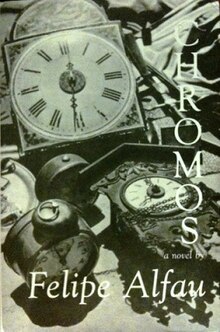
Chromos is the second novel of Spanish-born American writer Felipe Alfau (1902–1999), written in 1948 and published in 1990.
Alfau described how he wrote the novel: "In the office between one document and another, I would write a paragraph or two. I then pasted together the whole book, as in a collage." [1] He completed it in 1948, but not published until 1990 [2] when Dalkey Archive Press released the first edition. [3]
The novel was nominated for a National Book Award [3] in 1990. [2]
Chromos had an influence on the works of fellow Spanish-American writer Eduardo Lago, whose Llámame Brooklyn shares stylistic, structural, and thematic similarities with Alfau's novel, such as a novel-within-a-novel. [4]
- ^ Galasso 2010, p. 44.
- ^ a b Villeneuve 2013, p. 1.
- ^ a b Galasso 2010, p. 43.
- ^ Galasso 2010, pp. 43–44.
- Galasso, Regina (2010). "The Lifeline of Chromos: Translation and Felipe Alfau" (PDF). TranscUlturAl. 1 (3): 43–55. doi: 10.21992/T97H0M.
- Villeneuve, Philippe (2013). Confabulation, Collaboration, and Chromolithography: Memory as Construct in the Works of Felipe Alfau (Ph.D.). University of Ottawa. hdl: 10393/24408.
- Scott, Joseph B. (2005). Thundering out of the shadow: modernism and identity in the novels of Felipe Alfau (Master of Arts). University of Missouri–Columbia. hdl: 10355/4277.

Chromos is the second novel of Spanish-born American writer Felipe Alfau (1902–1999), written in 1948 and published in 1990.
Alfau described how he wrote the novel: "In the office between one document and another, I would write a paragraph or two. I then pasted together the whole book, as in a collage." [1] He completed it in 1948, but not published until 1990 [2] when Dalkey Archive Press released the first edition. [3]
The novel was nominated for a National Book Award [3] in 1990. [2]
Chromos had an influence on the works of fellow Spanish-American writer Eduardo Lago, whose Llámame Brooklyn shares stylistic, structural, and thematic similarities with Alfau's novel, such as a novel-within-a-novel. [4]
- ^ Galasso 2010, p. 44.
- ^ a b Villeneuve 2013, p. 1.
- ^ a b Galasso 2010, p. 43.
- ^ Galasso 2010, pp. 43–44.
- Galasso, Regina (2010). "The Lifeline of Chromos: Translation and Felipe Alfau" (PDF). TranscUlturAl. 1 (3): 43–55. doi: 10.21992/T97H0M.
- Villeneuve, Philippe (2013). Confabulation, Collaboration, and Chromolithography: Memory as Construct in the Works of Felipe Alfau (Ph.D.). University of Ottawa. hdl: 10393/24408.
- Scott, Joseph B. (2005). Thundering out of the shadow: modernism and identity in the novels of Felipe Alfau (Master of Arts). University of Missouri–Columbia. hdl: 10355/4277.